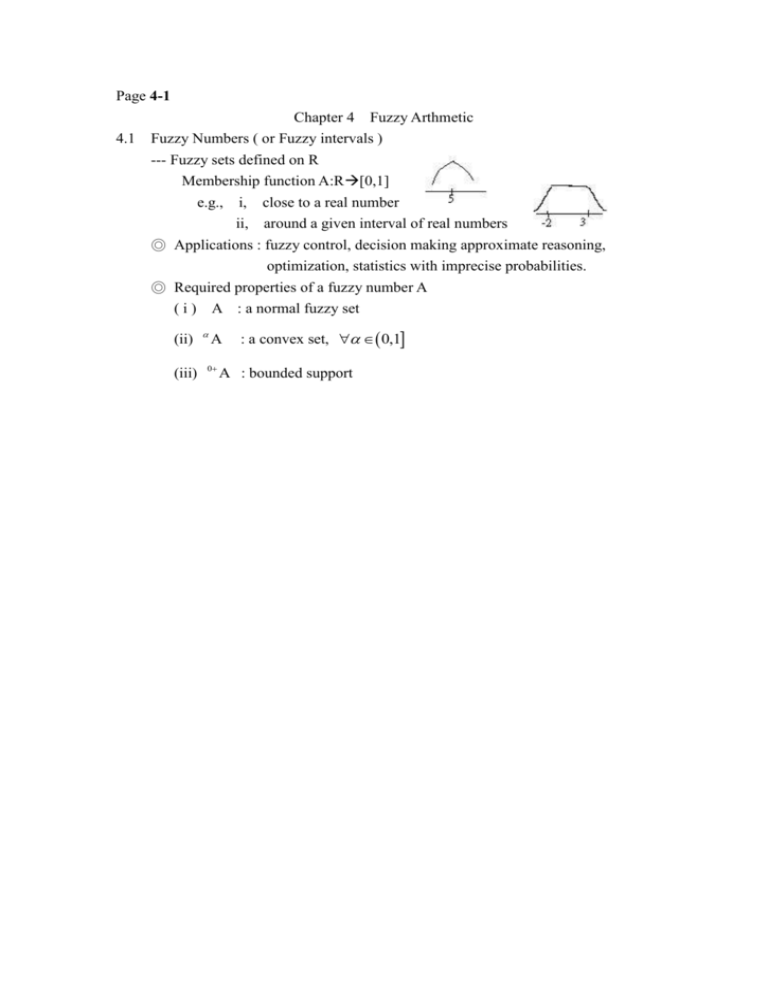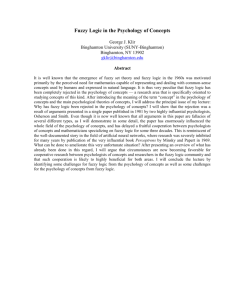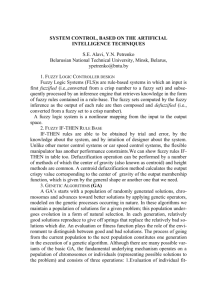Chapter 4 Fuzzy Arthmetic
advertisement

Page 4-1
Chapter 4 Fuzzy Arthmetic
4.1 Fuzzy Numbers ( or Fuzzy intervals )
--- Fuzzy sets defined on R
Membership function A:R[0,1]
e.g., i, close to a real number
ii, around a given interval of real numbers
◎ Applications : fuzzy control, decision making approximate reasoning,
optimization, statistics with imprecise probabilities.
◎ Required properties of a fuzzy number A
( i ) A : a normal fuzzy set
(ii)
(iii)
A
0
: a convex set, 0,1
A : bounded support
Page 4-2
◎ Cases of fuzzy numbers
Crisp
fuzzy
an
ordinary
member
an
interval
of
numbers
◎ Membership functions of fuzzy numbers need not be symmetric
large number
small number
Page 4-3
◎Membership function may
be piecewise-defined
Theorem 4.1 : Let A F ( R) A : a fuzzy number
fuzzy power
iff a, b
Normal
b.
Convex
c.
bounded
x a, b
1
A( x) l ( x)
r ( x)
Where a.
s.t.
a.
x , a
----- ( 4.1 )
x b,
b, Monotonic increasing
l : , a 0,1 : c, Continuous from right
d , l ( x) 0, x (, w )
1
Monotonic decreasing
r : (b, ) 0,1 : Continuous from left
r ( x) 0, x ( w )
2,
Proof:
I, hecessity =>
1.
A : normal
1A
Let 1 A a, b
2. prove that the left part of A agree with l
(a )l :
( a , ) 0 , 1
(b) Monotonic increasing
(c) Continuous from right
(d )l ( x) 0, x (, w )
1
Page 4-4
a, 0 A( x) 1, x (, a)
( A (a ) 1 )
with l : (, a) 0,1
A : ( a,
) 0 , agree
1
b. Let x y a, A( y) min A( x), A(a) A( x)
Theorem1.1
(1)
A(a) 1
(A:convex)
A : increasing agree with l : monotonic increasing
c. assume A(x): not continuous from the right
Let x0 (, a) , be a discontinuous pt.
a sequence
xn , s.t.
xn x0 , n
and lim xn x0
n
increasing
Let lim A( xn ) A( x0 )
n
A : closed interval (
x0 A
A : convex)
contradict
A( x0 )
A( x) : continuous from right
d.
A : fuzzy number
0
A : bounded
w1 , s.t.
A( x) 0, x , w1
Page 4-5
3, prove r :
monotonic decreasing
Continuous from the left
r : (b
,
)
[ 0 , 1]
r ( x) 0 x (2w , )
II.
Sufficiency
i.
A defined by (4.1) is normal -----(a)
ii.
iii.
and its support 0 A : bounded----(b)
prove (0,1], A : a closed interval (i.e. A: convex)
proof : let
X inf{x | l ( x) , x a} ----(c)
Y s u p {x r| x( )
x, ---(d)
b }
Show that
A : closed (i.e.,
A [ X , Y ] )
(A) prove A [ X , Y ]
proof : x0 A , if x0 a A( x0 ) l ( x0 )
i.e., x0 {x | l ( x) , x a}
x0 i n f {x l| x( )
x, a }---(i)
x
Page 4-6
if x0 b A( x0 ) r ( x0 )
i.e., x0 {x | r ( x) , x b}
x0 s u p {x r| x( )
x, b } y
x0 [ X , Y ] A [ X , Y ]
(B) prove [ X , Y ] A (idea [ x , y ] A :)
proof : from (c) , i.e. X inf{x | l ( x) , x a}
a sequence {xn } in {x | l ( x) , x a}
s.t.
lim xn x
n
l : continuous from right
l ( x ) x ( l ixm
ll xi nm ( )
n )
n
n
x A similarly
[ x , y ]
( A ) (B
)
x[
y A
A
y, ] :Aa closed interval
(i)(ii)(iii)=> complete sufficiency
(I)(II) => complete theorem
※ Every fuzzy number can be represented in the form of (4.1)
Page 4-7
Examples
(a)
w1 a b w2 1.3
x (,1.3), l ( x) 0
x (1.3, ), r ( x) 0
(b)
w1 a 1.25, w2 b 1.35
x (,1.25), l ( x) 0
x (1.35, ), r ( x) 0
(c)
a b 1.3,
w1 1.2, w2 1.4
l ( x)
r ( x)
x (,1.2)
0
1 0 x( 1 .3 )
1 x [ 1 . 2 , 1 . 3 )
1 0 ( 1 . 3x )
1 x( 1 . 3 , 1 . 4 ]
x (1.4, )
0
(d)
a 1.28, b 1.32
w1 1.2, w2 1.4
l ( x)
r ( x)
0
1 2 . 5x (
x (,1.2)
1 .2 8 )
1 2 . 5 ( 1 . 2x 8
0
)
1x [ 1 . 2 , 1 . 2 8 )
1x ( 1 . 3 2 , 1 . 4 ]
x ( 1 . 4,
)
Page 4-8
a = 90, b=100
w1 77.5, w2 100
x , 77.5
0
l ( x)
0.08( x 90) 1 x 77.5,
r ( x) 0, x (100, )
◎ Fuzzy Cardinality A
A. a fuzzy number defined on N
A
Example
A
Page 4-9.
| D2 |
0.13 0.27 0.4 0.53 0.67 0.8 0.93 1.0
19
17
15
13
11
9
7
5
e.g.
x {30,50}, D2 ( x) 0.67
50 30
1 11
2
B. Scalar Cardinality | A |
| A |
| A |
A( x)
xsup( A)
Example :
| D2
| 0 . 1 3 * 2
0 . 27 * 2
0 . 4 * 2 0 . 5 3 * 2
0 . 67 ** 22 10*. 85 * 21 2 .04. 69 3
Page 4-10
4.3 Arithmetic Operations on Fuzzy Numbers
Idea: Define operations in terms of arithmetic operations on α-cuts which are
a subject of interval analysis of classical mathematics.
※ Fuzzy number can uniquely be represented by theirα-cuts.
⊙Classical interval analysis
‧ 4 operations:
+,-,‧,/
Let * denote any of the 4 operations→
a, b d , e f g | a f
except a, b/d , e when
b, d g e
0 [ d , e]
※ The result of an operations on closed intervals is a closed interval.
Page 4-11
●Definitions of operations
[a, b] [d , e] [a b, b e]
[a, b] [d , e] [a b, b e]
[a, b] [d , e] [min( ad , ae, bd , be), max( ad , ae, bd , be)]
[a, b] /[ d , e] [a, b] [1 / e,1 / d ] [min(
where 0 [d , e]
●Examples:
1.[2,5]+[1,3]=[3,8]
2.[2,5]-[1,3]=[-1,4]
3.[3,4]‧[2,2]=[6,8]
4..[4,10]/[1,2]=[2,10]
a a b b
a a b b
, , , ), max( , , , )]
d e d e
d e d e
Page 4-12
●Properties of Operations
Let A [a1 , a2 ] , B [b1 , b2 ] , C [C1 , C2 ] , 0 [0,0] , 1 [1,1]
A B B A
1. Commutativity
A B B A
( A B) C A ( B C )
2. Associativity
( A B) C A ( B C )
A 0 A A 0
3. Identity
A 1 A A 1
4. Subdistributivity A ( B C ) A B A C
5. Distributivity
If b B, c C , b c 0, A ( B C ) A B A C
6. 0 A A,1 A / A,0 A
7. Inclusion monotonicity
If A E , B F
A B
A B
A B
A / B
EF
EF
EF
E/F
Page 4-13
● Prove Subdistrubutivity: ( A ( B C ) A B A C )
Proof: A ( B C ) {a (b c) | a A, b B, c C}
{a b a c) | a A, b B, c C}
Less Re striction (loose ) {a b a c) | a, a A, b B, c C} A B A C
( A (B C) A B A C)
● Example:
Let A=[0,1], B=[1,2], C=[-2,-1]
A B [0,1] [1,2] [0,2]
A C [0,1] [2,1] [2,0]
B C [1,2] [2,1] [1,1]
A ( B C ) [0,1] [1,1] [1,1]
A B A C [0,2] [2,0] [2,2]
A (B C) A B A C
Page 4-14
˙ Prove Distributivity : ( f b B, c C , b c 0,
A (B C) A B A C )
Proof : Let A [a1 , a2 ], B [b1 , b2 ], C [c1 , c2 ]
1. assume
B,C
i.e , b1 , c1 0
0
Case 1 : a1 0
A ( B C ) [a1 (b1 c1 ), a2 (b2 c2 )]
[a1b1 a1c1 ), a2b2 a2c2 )]
[a1b1 , a2b2 ] [a1c1 , a2c2 )]
A
[
]
0
Case2 : a2 0
( A) [a2 , a1 ]
( A) ( B C ) )( A) B ( A) C
A
A (B C) A B A C
[
]
0
Case3 : a1 0, a2 0
A ( B C ) [a1 (b2 c2 ), a2 (b2 c2 )]
[a1 b2 , a2 b2
] [ a1 c2, a2 c]2
A B A C
A
[
]
0
B,C
, i.e., b2 , c2 0
2. Similarity ,
0
Page 4-15
4.4 . Arithmetic Operations on Fuzzy Numbers
Fuzzy Arithmetic :
Interval arithmetic
Extension principle
⊙Interval arithmetic method
( A B) A B
see theorem 4.2 (c)
*: arithmetic operation
From Theorem 2.5
A B
( A B)
[0,1]
˙Example :
Let A(x) =
x 1, x 3
0
1 x 1
1 x 3
(x+1)/2
(3-x)/2
B(x) =
x 1, x 5
0
1 x 3
(5-x)/2
3 x 5
A [2 1,3 2], B [2 1,5 2]
now,
(x-1)/2
( A B) [4,8 4]
( 0 , 1 ]
( A B) [4 6, 2 4]
( 0 , 1 ]
( A B)
=
( A / B)
=
0.5
Both A, B 0
[4 2 12 5, 4 2 16 15]
[4 1, 4 16 15]
[ ( 2 1 ) / ( 2 1 ) , ( 3 2 ) / ( 2
[ ( 2 1 ) / (5 2 ) , ( 3 2 ) / ( 2
2
2
( 0 , . 5 ]
( . 5 , 1 ]
1)(]0 , . 5 ]
1)(]. 5 , 1 ]
Page 4-16
From [4,8 4]
f (4 )
g ( 8 4 )
f ( )
4
g ( )
8
4
f ( x)
x
4
g ( x)
8 x
4
0 1
0 4 4
i.e., 0 x 4
(A+B)(x)=
0 1
0 4 4
0 4 4
8 8 4 4
i.e., 4 x 8
0
x 0, x 8
x
4
0 x4
8 x
4
4 x 8
Page 4-17
( A B)( x)
0
x 0, x 8
x
4
0 x4
8 x
4
( A B )( x)
( A B )( x)
4 x 8
0
x 6, x 2
x6
4
6 x 2
2 x
4
2 x 2
x 5, x 15
0
1
2
3 ( 4 x )
2
5 x 0
1
( 1 x 2)
2
0 x3
1
2
4 ( 1 x )
2
3 x 1 5
Page 4-18
0
[3 (4 X )1 / 2 ] / 2
Show ( A B)( X )
1/ 2
(1 X ) / 2
[4 (1 X )1 / 2 ] / 2
X 5, X 15
5 X 0
0 X 3
3 x 15
[4 2 12 5,4 2 16 15], (0,0.5]
From: ( A B)
[4 2 1,4 2 16 15], (0.5,1]
A. Let x 4 2 12 5 4 2 12 (5 x) 0 by 公式:
x
b b 2 4ac
2a
3 4 x
(0,0.5]
2
As
00
0
3 4 x
3 4 x
其中
(不能成立)( 3 4 x 0, 4 x 3, 不可能)
2
2
3 4 x
x 5
2
As 0.5 0.5
3 4 x
1 3 4 x
,0.5
(不能成立)
2
2
2
1 3 4 x
x0
2
2
5 x 0
0.5
B.
Let x 4 2 16 15 4 2 16 15 x 0
4 1 x
(0,0.5]
2
As 0 0
0
4 1 x
4 1 x
,0
(不能成立)
2
2
4 1 x
x 15
2
As 0.5 0.5
4 1 x
1 4 1 x
,0.5
(不能成立)
2
2
2
1 4 1 x
x8
2
2
8 x 15
0.5
Page 4-19
x 4 2 16 15 4 2 16 15 x 0
4 (1 x)
2
(0.5,1]
x 4 2 1 4 2 1 x 0
C. Let
4 (1 x)
2 4 (1 x)
,1
2
2
2
1 4 (1 x)
0.5
x8
2
2
4 (1 x)
5 8 x 15 x
x8
2
11
(1 x)
2
(0.5,1]
As
0.5 0.5
(1 x)
1
2
2
x 0
0 x 3
D. Let x 4 2 16 15 4 2 16 15 x 0
4 (1 x)
2
(0.5,1]
As 0.5 , 0.5
0.5
4 (1 x)
(不能成立)
2
1 4 (1 x)
x8
2
2
As 1 1
4 (1 x)
2 4 (1 x)
,1
(不可能成立)
2
2
2
2 4 (1 x)
x3
2
2
3 x 8
1
By (A),(B),(C),(D)
(A).when 5 x 0 x
3 (4 x)
2
(B).when 8 x 15 x
4 (1 x)
2
(C).when 0 x 3 x
(D).when 3 x 8 x
i.e
4 (1 x)
2
x 5, x 15
0
3
( A B)
(1 x)
2
( 4 x )
2
( 1 x )
2
4
( 1 x )
2
5 x 0
0 x3
3 x 1 5
Page 4-20
(A/B)(x)=
0
Derivation : from
x
let x=
(5x+1)/(2x+2)
0
(3-x)/(2x+2)
1/ 3 x 3
( A / B)
[
x
0
-1
2 1 3 - 2
,
]
2 + 1 2 + 1
2 1 3 - 2
,
]
5 2 2 + 1
1/3
x
[0,0.5]
[0.5,1]
2 1
, (2 +1)x=2 1 2x +x=2 -1
2 +1
( 2x 2) 1x
as 0 0
1 x
2 2x
,
(0, 0.5]
1 x
x 1 ( )
2 2x
as 0.5 0.5
ii, Let
, x3
(x+1)/(2-2x)
[
i.
-1
1 x
1 x 1 x x 0 [ ]
2 2x
3 2
3 x
,
2 1
2x 2
(0.5,1] 1 x 3
x
f3 ( x)
2 1
5x 1
,
5 2
2 2x
1
(0.5,1] 0 x
3
x
iii, Let
f 4 ( x)
3 2
3 x
,
2 1
2x 2
1
(0.5,1] x 1
3
x
iv, Let
f 4 ( x)
1
x3
3






